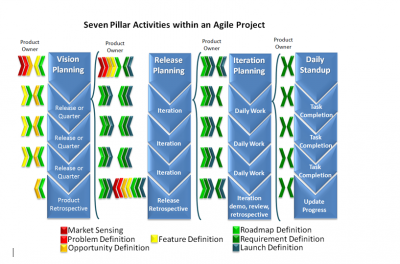Val Workman
The opinions expressed by the bloggers below and those providing comments are theirs alone, and do not necessarily reflect the opinions of Ryma Technology Solutions. As they say, you can't innovate without breaking a few eggs...
- Font size: Larger Smaller
- Hits: 54485
- 3 Comments
- Subscribe to this entry
- Bookmark
Product Management for Agile Projects
I've blogged in the past about the Seven Pillars of Product Management and indicated that the
activities of each of the pillars are asynchronous. We tend to think of the Seven Pillars as if they were a
framework of process flowing from left to right, which isn't correct. The Seven Pillars are asynchronous
activities working concurrently. Each Pillar consumes and produces stock piles of product management
assets such as the problem statement or market requirement. The Seven Pillars are adapted to many
types of processes, frameworks and methodologies. This post shows the activities of the Seven Pillars
within the constructs of an Agile project.
In today's competitive environment you can't afford to delay the agile project while sequentially
stepping through each of the activities of the Seven Pillars. In the Agile project, these activities are
iteratively elaborated upon, in increased levels or robustness. This produces just in time definition for
the various levels of iteration through the agile project.
Much of the product management information isn't available during the Planning Phase, or worse, the
market data becomes stale before it's used. Organizations trying to use sequential product management
processes find it very difficult to support agile projects. The conflict is that the Product Owner is trying
to do everything up front before any development work is done in the agile project. The solution is for
the Product Owner to keep focused on the objectives of the Seven Pillars, while changing the way the
objectives are accomplished.
In an Agile project, this means elaborating upon the product management assets in spiral iterations.
With each turn in the spiral, more fidelity is added to each pool of assets. Product Management is still a
team sport and the Product Owner works with that team asynchronously building out the asset in each
pool.
As an example, the objective of the Roadmap Definition Pillar is to create a roadmap that delivers the
most competitive advantage possible, within a given set of business constraints and strategies. During
the Vision Planning Phase of an Agile project, all the activities leading up to a high-level roadmap are
completed. This high-level information is used during the Vision Planning Phase of an Agile Project to:
• Establish Business Relationships, Define the Product Opportunity, and Define Initial Feature–Set
• Create Product Cyclone, Begin the Physical Database Description (PDD), Define Arch Significant
Terms, Identify Risks, Issues, Concerns, Problems, and Draft Estimate if Necessary
These activities typically complete the Discovery Iteration of the Vision Planning Phase and are
sometimes labeled as 'Iteration -1'. These activities might be accomplished in one iteration or a few
mini-iterations.
The actual execution sequence of the Pillars during this Discovery Iteration depends on the pool
levels of market evidence and problem statements. Normally there's enough in the market evidence
and problem statement pools to warrant Opportunity Definition. At this point, the Product Owner is
developing product opportunity definitions, product innovation and roadmap charters with the business
sponsors.
These assets are then used by the Product Owner to define an initial set of product features
or characteristics which can be used to guide the Agile Project Manager and the Agile Product
Development Team Lead in the development of the PDD, Arch Terms, and additional problem
statements. The Product Owner is also using these problem statements along with other relevant
problem statements from the asset pool to define opportunities, and any additional features.
Iteration 0 is used to finalize the Vision Planning Phase of the Agile project. During this Phase the
Product Owner will build and post the approved product roadmap and the Communication Plan while
the rest of the planning team will be:
• Setting up Project Infrastructure, Approve Product Cyclone, Approve PDD, , Assess Project Risk,
Team Commits to Dates, Stage Gate Meeting Might be Held, POC’s Completed if Needed, Test
Strategy Defined, Source Control Planned, Automate Build, Automate Unit Tests, Create CI
Process, and Team Readied to Build
• If there is going to be a Gate 0 review, it will be after these activities are completed.
With each release, these activities are reviewed, and adjustments to the Vision Planning Phase will be
made until it's time to put the product through the End-of-Life sequence. In the diagram below I show
the Vision Planning Phase in a light blue color on the far left side. On the left of this Vision Planning
column, I've shown the multi-colored activities of the Product Owner and the Product Management
Team corresponding to the initial planning and each release. The colored chevrons pointing toward the
Phase Iteration are inputs into the Phase, while those pointing away from the Phase are Pillar objectives
accomplished by the Phase. After the first Vision Planning, each release may modify the product
roadmap, and identify new product opportunities. Each proceeding release will require an updated
roadmap, and any additional features targeted or modified.
This diagram below represents a hierarchical decomposition of the Agile project. I've included the Pillar
activities of the Product Owner at each level. While it's true that with the daily work of an iteration
and tasks of the daily standup, the Product Owner is primarily working with market requirements, and
updating the release and iteration plan, a full set of Pillar activities is conducted between each release to
leverage lessons learned from the market response to the previous release.
As releases proceed, from the top of the diagram to the bottom, asset pools are populated with more
assets at higher-levels of asset fidelity. Each level represents a turn of the elaboration spiral through
the Seven Pillars. The feedback provided during the daily work and tasks of the iteration facilitates
concurrent asynchronous product management. What used to take months of product management
lead-time prior to the kickoff of an Agile project, is now be integrated into the project through an
elaborative spiral which completes the objectives of each Pillar when the product management
information is needed.











If you are not 95, then it is not okay to inflict your preferences in temperature, lighting and air freshener on innocent passersby.